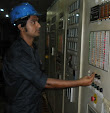Cooling Water Additives and Treatment
In
order to prevent corrosion, scale deposits or other deposits in closed
circulating water systems, the water must be treated with additives.
Before
treatment, the water must be limpid and meet the specification found in the end
of this chapter. Further, the use of an approved cooling water additive or
treatment system is mandatory.
NOTE
|
|
Distilled
water without additives absorbs carbon dioxide from the air, which involves
great risk of corrosion.
|
|
Sea
water will cause severe corrosion and deposit formation even if supplied to the
system in small amounts.
Rain
water has a high oxygen and carbon dioxide content; great risk of corrosion;
unsuitable as cooling water.
If
risk of freezing occurs, please contact the engine manufacturer for use of
anti-freeze chemicals.
Fresh
water generated by a reverse osmosis plant onboard often has a high chloride
content (higher than the permitted 80 mg/l) causing corrosion.
NOTE
|
|
The
use of glycol in the cooling water is not recommended, if it is not necessary.
Since glycol alone does not protect the engine against corrosion,
additionally an approved cooling water additive must always be used!
|
|
Additives
As
additives, use approved products from well-known and reliable suppliers. In
marine applications suppliers’ wide distribution networks makes it easier to
get the same product in different geographical locations.
CAUTION
|
|
The
use of emulsion oils, phosphates and borates (sole) is not accepted.
|
|
In
an emergency, if compounded additives are not available, treat the cooling
water with sodium nitrite (NaNO2) in portions of 5 kg/m3. To obtain a pH value
of 9, add caustic soda (NaOH), if necessary.
WARNING
|
|
Sodium
nitrite is toxic. Handle with care and dispose all possible residuals in
accordance with valid environmental regulations.
|
|
 |
| Nitrate oxidation curve |
Corrosion rate as a function of
nitrite concentration
Nitrite based cooling water additives are so called anodic
inhibitors and require proper dosing and maintenance in order to serve as
intended.
The nitrite of the additive is as such a salt and it will increase
the conductivity of the water. The conductivity is on the other hand one of the
main parameters affecting the corrosion rate once a corrosion process gets
started, the higher the conductivity the higher the corrosion rate.
If the conditions (nitrite level, chlorides, pH, etc.) in the
systems are such that the nitrite based additive is no longer able to protect
the entire surface of the system there may occur a rapid, local corrosion in
the areas that are not protected.
The corrosion rate at the attacked areas will even be much greater
than it would be with no additive at all present in the system.
Treatment
When
changing the additive or when entering an additive into a system where
untreated water has been used, the complete system must be thoroughly flushed
and if necessary chemically cleaned and rinsed before fresh treated water is
poured into the system. If, against our recommendations, an emulsion oil has
been used, the complete system must be absolutely cleaned of oil and greasy
deposits.
Evaporated
water should be compensated by untreated water; if treated water is used the
content of additives may gradually become too high. To compensate for leakage
or other losses, add treated water.
In
connection with maintenance work calling for drainage of the water system, take
care of and reuse the treated water.
NOTE
|
|
Ask
the supplier of the treatment product for instructions about treatment procedure,
dosage and concentration control.
|
|
Most suppliers will
provide a test kit for the concentration control. Additionally a frequent
laboratory analysis of cooling water at 3 months interval is recommended to
ensure safe engine operation.
VISITORS ZONE
|
Q:What is the function of micron filter?
How a membrane filter work and its properties?
Please put your answer in comment section for discussion









Hi all,
ReplyDeleteWater cooling is commonly used for cooling automobile internal combustion engines and large industrial facilities such as steam electric power plants, hydroelectric generators, petroleum refineries and chemical plants. Thanks a lot!